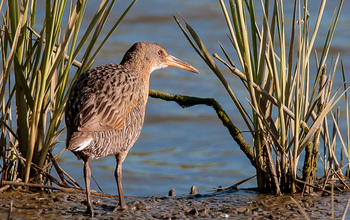Eradicating invasive species sometimes threatens endangered ones

Endangered California Clapper Rail near invasive Spartina along San Francisco Bay. Credit: Robert Clark
In results of a study published this week in the journal Science, researchers at the University of California, Davis, examine one such conundrum now taking place in San Francisco Bay. The study was led by UC Davis researcher Adam Lampert.
“This work advances a framework for cost-effective management solutions to the conflict between removing invasive species and conserving biodiversity,” said Alan Tessier, acting deputy division director in the National Science Foundation's (NSF) Directorate for Biological Sciences, which supported the research through NSF's Dynamics of Coupled Natural and Human Systems (CNH) Program.
CNH is also co-funded by NSF's Directorates for Geosciences and Social, Behavioral & Economic Sciences.
“The project exemplifies the goals of the CNH program,” says Tessier, “which are to advance the understanding of complex systems involving humans and nature.”
The California Clapper Rail–a bird found only in San Francisco Bay–depends on an invasive salt marsh cordgrass, hybrid Spartina, as nesting habitat.
Its native habitat has slowly vanished over recent decades, largely due to urban development and invasion by Spartina.
Study results show that, rather than moving as fast as possible with eradication and restoration plans, the best approach is to slow down the eradication of the invasive species until restoration or natural recovery of the system provides appropriate habitat for the endangered species.
“Just thinking from a single-species standpoint doesn't work,” said paper co-author and UC-Davis environmental scientist Alan Hastings.
“The whole management system needs to take longer, and you need to have much more flexibility in the timing of budget expenditures over a longer time-frame.”
The scientists combined biological and economic data on Spartina and on the Clapper Rail to develop a modeling framework to balance conflicting management goals, including endangered species recovery and invasive species restoration, given fiscal limitations.
While more threatened and endangered species are becoming dependent on invasive species for habitat and food, examples of the study's specific conflict are relatively rare–for now.
Another case where the eradication of an invasive species threatened to compromise the recovery of an endangered plant or animal is in the southwestern United States, where an effort to eradicate Tamarisk was cancelled because the invasive tree provides nesting habitat for the endangered Southwestern Willow Flycatcher.
“As eradication programs increase in number, we expect this will be a more common conflict in the future,” said paper co-author and UC Davis scientist Ted Grosholz.
Other co-authors include scientists James Sanchirico of UC Davis and Sunny Jardine of the University of Delaware.
Media Contacts
Cheryl Dybas, NSF, (703) 292-7734, cdybas@nsf.gov
Kat Kerlin, UCDavis, (530) 752-7704, kekerlin@ucdavis.edu
The National Science Foundation (NSF) is an independent federal agency that supports fundamental research and education across all fields of science and engineering. In fiscal year (FY) 2014, its budget is $7.2 billion. NSF funds reach all 50 states through grants to nearly 2,000 colleges, universities and other institutions. Each year, NSF receives about 50,000 competitive requests for funding, and makes about 11,500 new funding awards. NSF also awards about $593 million in professional and service contracts yearly.
Media Contact
More Information:
http://nsf.gov/news/news_summ.jsp?cntn_id=131478&org=NSF&from=newsAll latest news from the category: Ecology, The Environment and Conservation
This complex theme deals primarily with interactions between organisms and the environmental factors that impact them, but to a greater extent between individual inanimate environmental factors.
innovations-report offers informative reports and articles on topics such as climate protection, landscape conservation, ecological systems, wildlife and nature parks and ecosystem efficiency and balance.
Newest articles

Long-sought structure of powerful anticancer natural product
…solved by integrated approach. A collaborative effort by the research groups of Professor Haruhiko Fuwa from Chuo University and Professor Masashi Tsuda from Kochi University has culminated in the structure…

Making a difference: Efficient water harvesting from air possible
Copolymer solution uses water-loving differential to induce desorption at lower temperatures. Harvesting water from the air and decreasing humidity are crucial to realizing a more comfortable life for humanity. Water-adsorption…

In major materials breakthrough
UVA team solves a nearly 200-year-old challenge in polymers. UVA researchers defy materials science rules with molecules that release stored length to decouple stiffness and stretchability. Researchers at the University…



